fuel cap PORSCHE CAYNNE 2013 2.G Information Manual
[x] Cancel search | Manufacturer: PORSCHE, Model Year: 2013, Model line: CAYENNE, Model: PORSCHE CAYENNE 2013 2.GPages: 79, PDF Size: 14.97 MB
Page 3 of 79
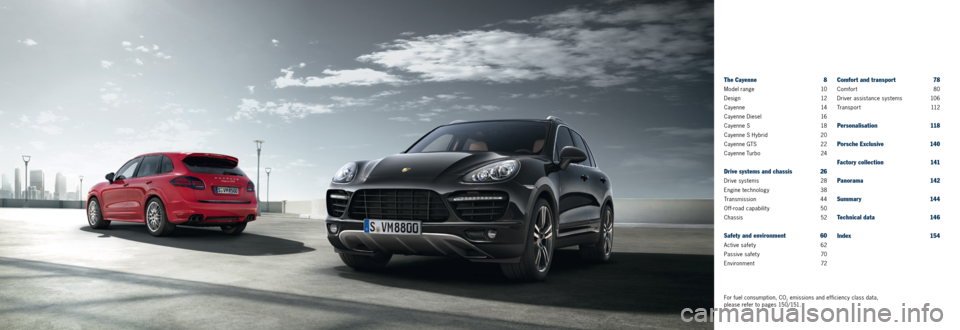
The Cayenne 8
Model range 10
Design
12
Cayenne
14
Cayenne Diesel
16
Cayenne S
18
Cayenne S Hybrid
20
Cayenne GTS
22
Cayenne Turbo
24
Drive systems and chassis 26
Drive systems 28
Engine technology 38
Transmission 44
Off-road capability 50
Chassis 52
Safety and environment 60
Active safety 62
Passive safety 70
Environment 72
Comfort and transport 78
Comfort 80
Driver assistance systems 10 6
Transport 112
Personalisation 118
Porsche Exclusive 140
Factory collection 141
Panorama 142
Summary 144
Technical data 146
Index 154
For fuel consumption, CO2 emissions and efficiency class data,
please refer to pages 150/151.
Page 6 of 79
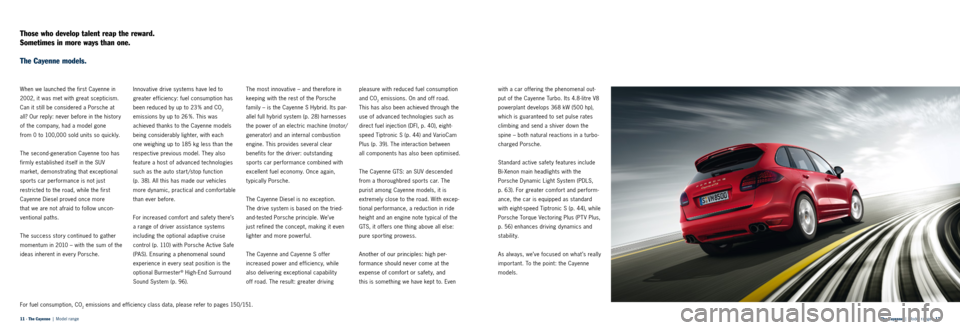
The Cayenne | Model range · 12
11 · The Cayenne | Model range
Those who develop talent reap the reward.
Sometimes in more ways than one.
The Cayenne models.
When we launched the first Cayenne in
2002, it was met with great scepticism.
Can it still be considered a Porsche at
all? Our reply: never before in the history
of the company, had a model gone
from 0 to 100,000 sold units so quickly.
The second-generation Cayenne too has
firmly established itself in the SUV
market, demonstrating that exceptional
sports car performance is not just
restricted to the road, while the first
Cayenne Diesel proved once more
that we are not afraid to follow uncon -
ventional paths.
The success story continued to gather
momentum in 2010 – with the sum of the
ideas inherent in every Porsche. Innovative drive systems have led to
greater efficiency: fuel consumption has
been reduced by up to 23
% and CO
2
emissions by up to 26 %. This was
achieved thanks to the Cayenne models
being considerably lighter, with each
one weighing up to 185 kg less than the
respective previous model. They also
feature a host of advanced technologies
such as the auto start/stop function
(p. 38). All this has made our vehicles
more dynamic, practical and comfortable
than ever before.
For increased comfort and safet y there’s
a range of driver assistance systems
including the optional adaptive cruise
control (p. 110) with Porsche Active Safe
(PAS). Ensuring a phenomenal sound
experience in every seat position is the
optional Burmester
® High-End Surround
Sound System (p. 96). The most innovative – and therefore in
keeping with the rest of the Porsche
family – is the Cayenne S Hybrid. Its par
-
allel full hybrid system (p. 28) harnesses
the power of an electric machine (motor/
generator) and an internal combustion
engine. This provides several clear
benefits for the driver: outstanding
sports car performance combined with
excellent fuel economy. Once again,
typically Porsche.
The Cayenne Diesel is no exception.
The drive system is based on the tried-
and-tested Porsche principle. We’ve
just refined the concept, making it even
lighter and more powerful.
The Cayenne and Cayenne S offer
increased power and efficiency, while
also delivering exceptional capability
off road. The result: greater driving pleasure with reduced fuel consumption
and CO
2 emissions. On and off road.
This has also been achieved through the
use of advanced technologies such as
direct fuel injection (DFI, p. 40), eight-
speed Tiptronic S (p. 44) and VarioCam
Plus (p. 39). The interaction bet ween
all components has also been optimised.
The Cayenne GTS: an SUV descended
from a thoroughbred sports car. The
purist among Cayenne models, it is
extremely close to the road. With excep -
tional performance, a reduction in ride
height and an engine note t ypical of the
GTS, it offers one thing above all else:
pure sporting prowess.
Another of our principles: high per -
formance should never come at the
expense of comfort or safet y, and
this is something we have kept to. Even
with a car offering the phenomenal out -
put of the Cayenne Turbo. Its 4.8-litre V8
powerplant develops 368 kW (500 hp),
which is guaranteed to set pulse rates
climbing and send a shiver down the
spine – both natural reactions in a turbo -
charged Porsche.
Standard active safety features include
Bi-Xenon main headlights with the
Porsche Dynamic Light System (PDLS,
p. 63). For greater comfort and perform -
ance, the car is equipped as standard
with eight-speed Tiptronic S (p. 44), while
Porsche Torque Vectoring Plus (PTV Plus,
p. 56) enhances driving dynamics and
stability.
As always, we’ve focused on what ’s really
important. To the point: the Cayenne
models.
For fuel consumption, CO
2 emissions and efficiency class data, please refer to pages 150/151.
Page 16 of 79
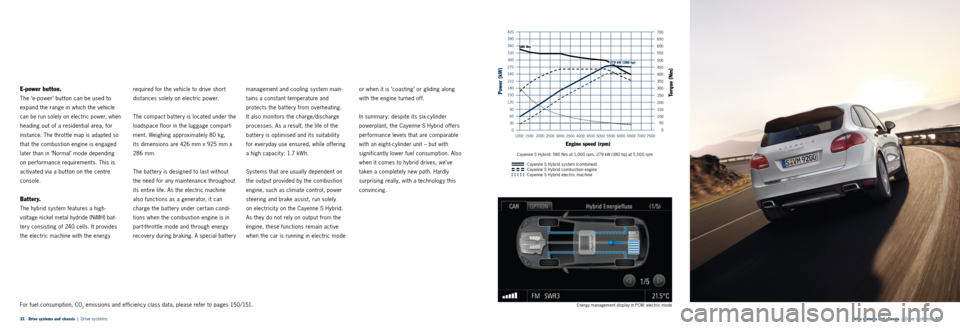
Drive systems and chassis | Drive systems · 32
31 · Drive systems and chassis | Drive systems
E-power button.
The ‘e-power’ but ton can be used to
expand the range in which the vehicle
can be run solely on electric power, when
heading out of a residential area, for
instance. The throt tle map is adapted so
that the combustion engine is engaged
later than in ‘Normal’ mode depending
on performance requirements. This is
activated via a but ton on the centre
console.
B at ter y.
The hybrid system features a high-
voltage nickel metal hydride (NiMH) bat-
tery consisting of 240 cells. It provides
the electric machine with the energy required for the vehicle to drive short
distances solely on electric power.
The compact bat tery is located under the
loadspace floor in the luggage compart -
ment. Weighing approximately 80 kg,
its dimensions are 426 mm x 925 mm x
286 mm.
The bat tery is designed to last without
the need for any maintenance throughout
its entire life. As the electric machine
also functions as a generator, it can
charge the bat tery under certain condi -
tions when the combustion engine is in
part-throt tle mode and through energy
recovery during braking. A special bat tery management and cooling system main
-
tains a constant temperature and
protects the battery from overheating.
It also monitors the charge/discharge
processes. As a result, the life of the
bat tery is optimised and its suitabilit y
for everyday use ensured, while offering
a high capacit y: 1.7 kWh.
Systems that are usually dependent on
the output provided by the combustion
engine, such as climate control, power
steering and brake assist, run solely
on electricit y on the Cayenne S Hybrid.
As they do not rely on output from the
engine, these functions remain active
when the car is running in electric mode or when it is ‘coasting’ or gliding along
with the engine turned off.
In summary: despite its six- cylinder
powerplant, the Cayenne S Hybrid offers
performance levels that are comparable
with an eight-cylinder unit – but with
significantly lower fuel consumption. Also
when it comes to hybrid drives, we’ve
taken a completely new path. Hardly
surprising really, with a technology this
convincing.
Cayenne S Hybrid system (combined)
Cayenne S Hybrid combustion engine
Cayenne S Hybrid electric machine
Energy management display in PCM: electric modeFor fuel consumption, CO2 emissions and efficiency class data, please refer to pages 150/151.
Cayenne S Hybrid: 580 Nm at 1,000 rpm, 279 kW (380 hp) at 5,500 rpm
100
50
0
300 350 400 450 500 550 600 650
0
30 60 90
120
150 180 210 240 270 300 330
150 200
250
Power (kW)
T orque (Nm)
1500
7500
2000 25003000 3500400045005000 5500600065007000
1000
Engine speed (rpm)
360 390 420
700580 Nm
279 kW (380 hp)
Page 18 of 79
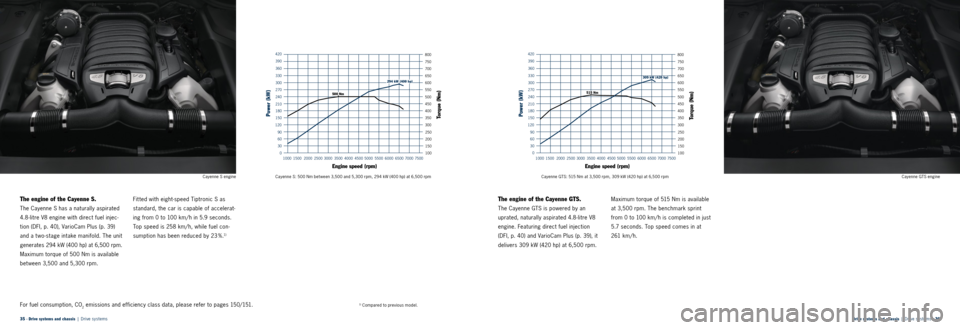
Drive systems and chassis | Drive systems · 36
35 · Drive systems and chassis | Drive systems
The engine of the Cayenne S.
The Cayenne S has a naturally aspirated
4.8-litre V8 engine with direct fuel injec -
tion (DFI, p. 40), VarioCam Plus (p. 39)
and a t wo -stage intake manifold. The unit
generates 294 kW (400 hp) at 6,500 rpm.
Maximum torque of 500 Nm is available
bet ween 3,500 and 5,300 rpm.
The engine of the Cayenne GTS.
The Cayenne GTS is powered by an
uprated, naturally aspirated 4.8-litre V8
engine. Featuring direct fuel injection
(DFI, p. 40) and VarioCam Plus (p. 39), it
delivers 309 kW (420 hp) at 6,500 rpm.
Cayenne S engine
Fit ted with eight-speed Tiptronic S as
standard, the car is capable of accelerat -
ing from 0 to 100 km/ h in 5.9 seconds.
Top speed is 258 km/ h, while fuel con -
sumption has been reduced by 23 %.
1)
Maximum torque of 515 Nm is available
at 3,500 rpm. The benchmark sprint
from 0 to 100 km/ h is completed in just
5.7 seconds. Top speed comes in at
261 k m / h.
Cayenne GTS engine
Cayenne S: 500 Nm bet ween 3,500 and 5,300 rpm, 294 kW (400 hp) at 6,500 rpm Cayenne GTS: 515 Nm at 3,500 rpm, 309 kW (420 hp) at 6,500 rpm
For fuel consumption, CO2 emissions and efficiency class data, please refer to pages 150/151.1) Compared to previous model.
100
300 350 400
450
500 550 600 6500
30 60 90
120
150 180 210 240 270 300
3301500
7500
2000 25003000 3500400045005000 5500600065007000 150 200
2501000
Power (kW)
T orque (Nm)
Engine speed (rpm)
360
700
390
750800
420
294 kW (400 hp)
500 Nm
100
300 350 400
450
500 550 600 650
0
30 60 90
120
150 180 210 240 270 300
330
1500 7500
2000 25003000 3500400045005000 5500600065007000 150 200
250
1000
Power (kW)
T orque (Nm)
Engine speed (rpm)
360
700
390
750
800
420
515 Nm
309 kW (420 hp)
Page 21 of 79

Drive systems and chassis | Engine technology · 42
41 · Drive systems and chassis | Engine technology
Compression with precision.
Essential for getting right to the point.
Direct fuel injection (DFI).
DFI injects fuel directly into the combus -
tion chamber at up to 120 bar with milli -
second precision using electromagnetic
injectors. The injector position and spray
geometry have been carefully designed
to improve output, torque, fuel economy
and emissions. The swirling of the fuel as
it enters each chamber increases the
mixing of air and fuel, thereby enhancing
combustion. By forming the air/fuel mix -
ture directly in the combustion chamber,
DFI contributes to engine cooling. As a
result, it was possible to increase the
compression ratio and therefore power
and efficiency.
Direct fuel injection on the diesel
engine (common-rail injection system).
On the Cayenne Diesel, direct fuel injec -
tion comes courtesy of a common-rail
injection system. The injection pressure
is now up to 2,000 bar, ensuring optimum
distribution of the air/fuel mixture – for
greater performance. The piezoelectric
injectors provide flexible injection rate
adjustment, using exactly metered
quantities of fuel, with multiple injections
for each power stroke to deliver smooth
combustion.
Cooling systems.
A high-performance engine can only
maintain its maximum capability over
a long service life if all components are
operating consistently within a specific
temperature range. The engines in the
Cayenne models are therefore designed
for efficient cooling.
In order to reduce the frictional losses
that occur during warm-up, all Cayenne
models feature comprehensive thermal
management. Using intelligent control,
it activates the different cooling circuits
individually and on demand, thereby
ensuring that the optimum operating
temperature for the engine and trans -
mission is reached more quickly. This
minimises friction – and keeps fuel
consumption and CO
2 emissions low.
The V8 engines have an enhanced coolant
management system offering effective
temperature control throughout the engine.
While 20 % of coolant flows longitudinally
through the crankcase, the remaining 80 %
serves the cylinder heads using the proven
cross-flow principle (from hot to cold).
On all Cayenne models, the piston heads
are cooled using oil-spray jets integrated
within the main lubrication system.
The entire cooling system is designed for
prolonged heav y-dut y use, e.g. off-road
driving or heav y towing and carrying
applications.
Lubrication.
The V8 engines use dry-sump lubrication
to ensure a consistent supply of oil in
all load conditions, especially in off-road
terrain. The oil reservoir is located inside
the engine. This saves on space and
reduces weight.
Oil is circulated around the V8 engines
using a demand-driven pump. This has
been designed for the toughest driving
scenarios on and off road, including per -
formance driving and extreme gradients.
The V6 engines have a wet-sump lubrica -
tion system. Ensuring a reliable supply of
oil, whatever the driving conditions.
For fuel consumption, CO
2 emissions and efficiency class data, please refer to pages 150/151.
Page 26 of 79

Drive systems and chassis | Off-road capability · 52
51 · Drive systems and chassis | Off-road capability
From urban jungle to the windy wilds.
The Cayenne is perfectly at home on any terrain.
Off-road capability.
Steep ascents leading to snow- covered
mountain lodges, boggy ground or
muddy, loose surfaces – all situations
that the Cayenne handles superbly with
intelligent all-wheel drive. The drive
systems featured on the Cayenne models
deliver exceptional torque. For plent y of
power on tap. On any terrain.
Operating concept.
With the help of Porsche Traction
Management (PTM), the Cayenne can
cope with even the most demanding
off-road scenarios. Simply move the
main off-road control on the centre
console forward or backward to select
one of up to three off-road modes
(depending on the model). Available
on the Cayenne, Cayenne Diesel,
Cayenne S, Cayenne GTS and Cayenne
Turbo, this
function readies the car for
off-road use or reverts the set ting to
normal road driving.
In Off-road Mode 1, for example, the
maps for all relevant systems, e.g. ABS,
are adapted to provide optimum traction.
In addition, High Level I is selected
on vehicles featuring air suspension
with PASM. If that ’s not enough, the air
suspension can be raised further to
High Level II to increase the approach/
departure angle and wading depth.
1)
Push the off-road control forward again
on the Cayenne, Cayenne S, Cayenne GTS
and Cayenne Turbo to activate Off-road
Mode 2 – for even greater traction on difficult terrain, the multi-plate clutch can
be fully locked.
The electronically variable rear diffe
r-
ential on the optional Porsche Torque
Vectoring Plus (PT V Plus, p. 56) is inte -
grated within the all-wheel drive system.
This automatically ensures the optimum
distribution of drive torque on particular -
ly uneven surfaces. If one of the rear
wheels begins to slip, the rear differential
varies the amount of torque transmit ted
through each drive shaft, thereby restor -
ing traction. In Off-road Mode 3, the rear
differential can be manually locked using
the main off-road control. Then both
rear wheels receive the same amount of
torque, regardless of surface conditions.
The optional PDCC (p. 55) enables greater wheel articulation in all three
modes, improving traction still further.
For effective prevention of damage to the
underside of the car, all Cayenne models
can be equipped with optional off-road
underbody protection comprising rock
rails with integrated skid plates, a
reinforced engine-bay guard, additional
protection for fuel tank and rear axle,
and a second towing lug.
1) The Cayenne GTS has a steel -spring spor ts suspension with a 24 mm reduction in ride height (20 mm reduction with optional air suspension). This will lead to restricted capabilit y when driving of f road.
Main off-road control
Page 28 of 79
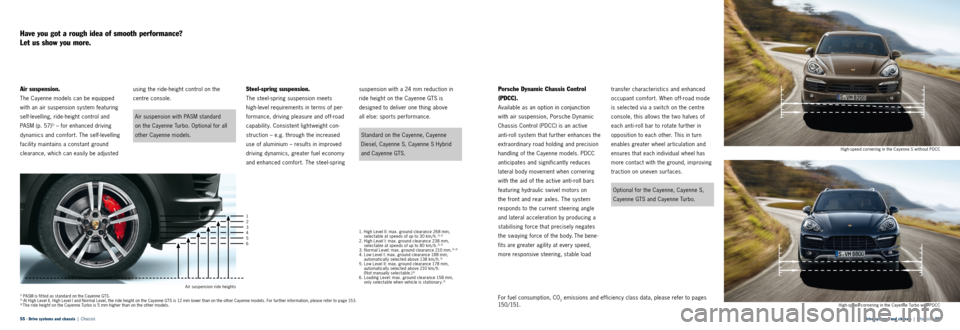
1
2
3
4
5
6
Air suspension ride heightsDrive systems and chassis | Chassis ·
56
55 · Drive systems and chassis | Chassis High-speed cornering in the Cayenne Turbo with PDCCHigh-speed cornering in the Cayenne S without PDCC
1) PASM is fit ted as standard on the Cayenne GTS.2)
At High Level II, High Level I and Normal Level, the ride height on the Cayenne GTS is 12 mm lower than on the other Cayenne models. For fur ther information, please refer to page 153.3) The ride height on the Cayenne Turbo is 5 mm higher than on the other models.For fuel consumption, CO2 emissions and efficiency class data, please refer to pages
15 0/ 151.
Have you got a rough idea of smooth performance?
Let us show you more.
Air suspension.
The Cayenne models can be equipped
with an air suspension system featuring
self-levelling, ride-height control and
PASM (p. 57)
1) – for enhanced driving
dynamics and comfort. The self-levelling
facility maintains a constant ground
clearance, which can easily be adjusted using the ride-height control on the
centre console.
Air suspension with PASM standard
on the Cayenne Turbo. Optional for all
other Cayenne models.
Steel-spring suspension.
The steel-spring suspension meets
high-level requirements in terms of per
-
formance, driving pleasure and off-road
capability. Consistent lightweight con -
struction – e.g. through the increased
use of aluminium – results in improved
driving dynamics, greater fuel economy
and enhanced comfort. The steel-spring suspension with a 24 mm reduction in
ride height on the Cayenne GTS is
designed to
deliver one thing above
all else: sports performance.
Standard on the Cayenne, Cayenne
Diesel, Cayenne S, Cayenne S Hybrid
and Cayenne GTS.
Porsche Dynamic Chassis Control
(PDCC).
Available as an option in conjunction
with air suspension, Porsche Dynamic
Chassis Control (PDCC) is an active
anti-roll system that further enhances the
extraordinary road holding and precision
handling of the Cayenne models. PDCC
anticipates and significantly reduces
lateral body movement when cornering
with the aid of the active anti-roll bars
featuring hydraulic swivel motors on
the front and rear axles. The system
responds to the current steering angle
and lateral acceleration by producing a
stabilising force that precisely negates
the swaying
force of the body. The bene-
fits are greater agilit y at every speed,
more responsive steering, stable load transfer characteris
tics and enhanced
occupant comfort. When off-road mode
is selected via a switch on the centre
console, this allows the t wo halves of
each anti-roll bar to rotate further in
opposition to each other. This in turn
enables greater wheel articu lation and
ensures that each individual wheel has
more contact with the ground, improving
traction on uneven surfaces.
Optional for the Cayenne, Cayenne S,
Cayenne GTS and Cayenne Turbo.
1. High Level II: max. ground clearance 268 mm,
selectable at speeds of up to 30 km/ h. 2), 3)2. High Level I: max. ground clearance 238 mm,
selectable at speeds of up to 80 km/ h. 2), 3)3. Normal Level: max. ground clearance 210 mm. 2), 3)4. Low Level I: max. ground clearance 188 mm,
automatically selected above 138 km/ h. 3)5. Low Level II: max. ground clearance 178 mm,
automatically selected above 210 km/ h.
(Not manually selectable.)
3)6. Loading Level: max. ground clearance 158 mm,
only selectable when vehicle is stationary. 3)
Page 75 of 79
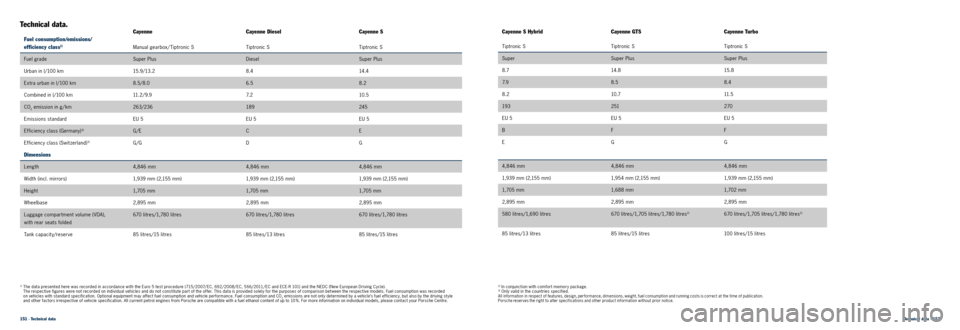
Technical data · 152
151 · Technical data
1) The data presented here was recorded in accordance with the Euro 5 test procedure (715/2007/ EC, 692/2008/ EC, 566/2011/ EC and ECE- R 101) and the NEDC (New European Driving Cycle). The respective figures were not recorded on individual vehicles and do not constitute par t of the of fer. This data is provided solely for the purposes of comparison bet ween the respective models. Fuel consumption was recorded on vehicles with standard specification. Optional equipment may af fect fuel consumption and vehicle per formance. Fuel consumption and CO2 emissions are not only determined by a vehicle’s fuel ef ficiency, but also by the driving st yle and other factors irrespective of vehicle specification. All current petrol engines from Porsche are compatible with a fuel ethanol content of up to 10 %. For more information on individual models, please contact your Porsche Centre.
CayenneCayenne DieselCayenne S
Fuel consumption/emissions/
efficiency class
1)Manual gearbox/ Tiptronic S Tiptronic STiptronic S
Fuel grade Super Plus DieselSuper Plus
Urban in l/100 km 15.9/ 13. 2 8.414 . 4
Extra urban in l/100 km 8.5/8.0 6.58.2
Combined in l/100 km 11. 2 / 9 . 9 7. 210. 5
CO
2 emission in g / km 263/236 189245
Emissions standard EU 5 EU 5EU 5
Efficiency class (Germany)
3)G/E CE
Efficiency class (Switzerland)
3)G/G DG
Dimensions
Length4,846 mm 4,846 mm 4,846 mm
Width (incl. mirrors) 1,939 mm (2,155 mm) 1,939 mm (2,155 mm)1,939 mm (2,155 mm)
Height 1,705 m m 1,705 m m 1,705 m m
Wheelbase 2,895 mm 2,895 mm 2,895 mm
Luggage compartment volume (VDA),
with rear seats folded 670 litres/1,780 litres
670 litres/1,780 litres670 litres/1,780 litres
Tank capacity/reserve 85 litres/15 litres 85 litres/13 litres85 litres/15 litres
Cayenne S HybridCayenne GTS Cayenne Turbo
Tiptronic S Tiptronic S Tiptronic S
Super Super Plus Super Plus
8.7 14 . 8 15.8
7. 9 8.5 8.4
8.2 10.7 11. 5
193 251 270
EU 5 EU 5 EU 5
B F F
E G G
4,846 mm 4,846 mm 4,846 mm
1,939 mm (2,155 mm) 1,954 mm (2,155 mm) 1,939 mm (2,155 mm)
1,705 m m 1,6 8 8 m m 1,702 m m
2,895 mm 2,895 mm 2,895 mm
580 litres/1,690 litres 670 litres/1,705 litres/1,780 litres
2)670 litres/1,705 litres/1,780 litres2)
85 litres/13 litres 85 litres/15 litres 100 litres/15 litres
2) In conjunction with comfort memory package.3) Only valid in the countries specified.All information in respect of features, design, per formance, dimensions, weight, fuel consumption and running costs is correct at the time of publication. Porsche reser ves the right to alter specifications and other product information without prior notice.
Technical data.
Page 76 of 79
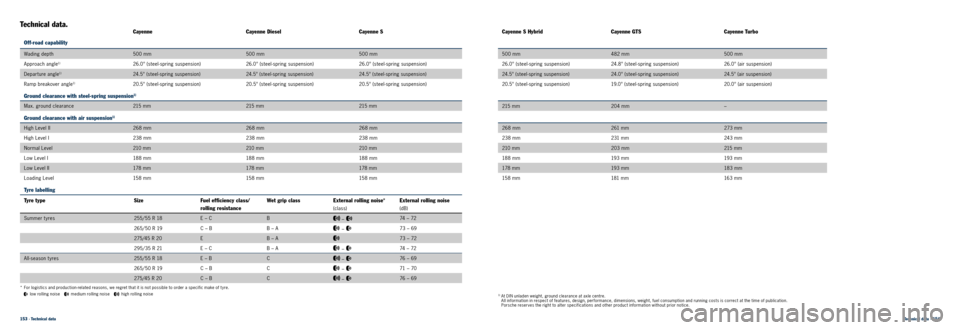
Technical data · 154
153 · Technical data
1) At DIN unladen weight, ground clearance at axle centre.
All information in respect of features, design, per formance, dimensions, weight, fuel consumption and running costs is correct at the time of publication.
Porsche reser ves the right to alter specifications and other product information without prior notice.
Cayenne Cayenne DieselCayenne S
Off-road capability
Wading depth 500 mm 500 mm500 mm
Approach angle
1)26.0° (steel-spring suspension) 26.0° (steel-spring suspension)26.0° (steel-spring suspension)
Departure angle
1)24.5° (steel-spring suspension) 24.5° (steel-spring suspension)24.5° (steel-spring suspension)
Ramp breakover angle
1)20.5° (steel-spring suspension) 20.5° (steel-spring suspension)20.5° (steel-spring suspension)
Ground clearance with steel-spring suspension1)
Max. ground clearance215 m m 215 m m 215 m m
Ground clearance with air suspension1)
High Level II 268 mm 268 mm268 mm
High Level I 238 mm 238 mm 238 mm
Normal Level 210 m m 210 m m 210 m m
Low Level I 18 8 m m 18 8 m m 18 8 m m
Low Level II 178 m m 178 m m 178 m m
Loading Level 15 8 m m 15 8 m m 15 8 m m
Cayenne S Hybrid Cayenne GTS Cayenne Turbo
500 mm 482 mm 500 mm
26.0° (steel-spring suspension) 24.8° (steel-spring suspension) 26.0° (air suspension)
24.5° (steel-spring suspension) 24.0° (steel-spring suspension) 24.5° (air suspension)
20.5° (steel-spring suspension) 19.0° (steel-spring suspension) 20.0° (air suspension)
215 m m 204 mm –
268 mm 261 m m 273 mm
238 mm 231 m m 243 m m
210 m m 203 mm 215 m m
18 8 m m 193 m m 193 m m
178 m m 193 m m 18 3 m m
15 8 m m 181 m m 16 3 m m
Technical data.
Tyre labelling
Ty r e t yp e SizeFuel efficiency class/
rolling resistance Wet grip class
External rolling noise*
(class)
External rolling noise
(dB)
Summer tyres 255/55 R 18E – CB
– 74 – 72
265/50 R 19 C – BB – A
– 73 – 69
275/45 R 20 EB – A
73 – 72
295/35 R 21 E – CB – A
– 74 – 72
All-season tyres 255/55 R 18 E – BC
– 76 – 69
265/50 R 19 C – BC
– 71 – 70
275/45 R 20 C – BC
– 76 – 69
* For logistics and production - related reasons, we regret that it is not possible to order a specific make of t yre.
low rolling noise medium rolling noise high rolling noise
Page 77 of 79
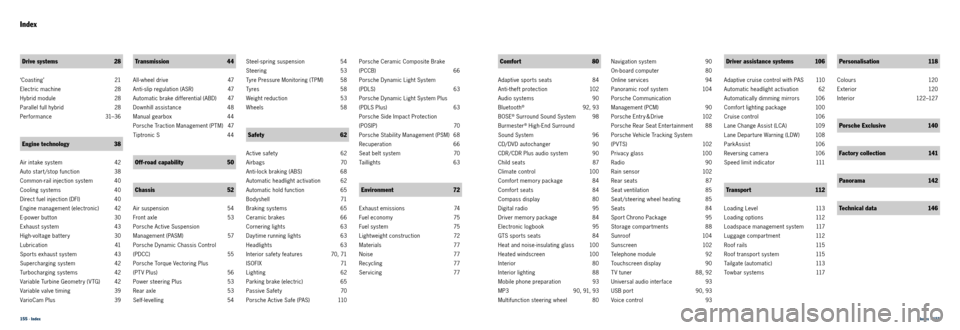
155 · IndexIndex · 155
Index
Drive systems 28
‘Coasting’ 21
Electric machine 28
Hybrid module 28
Parallel full hybrid 28
Performance 31–36
Engine technology 38
Air intake system 42
Auto start/stop function 38
Common-rail injection system 40
Cooling systems 40
Direct fuel injection (DFI) 40
Engine management (electronic) 42
E-power button 30
Exhaust system 43
High-voltage battery 30
Lubrication 41
Sports exhaust system 43
Supercharging system 42
Turbocharging systems 42
Variable Turbine Geometry (VTG) 42
Variable valve timing 39
VarioCam Plus 39
Transmission 44
All-wheel drive 47
Anti-slip regulation (ASR) 47
Automatic brake differential (ABD) 47
Downhill assistance 48
Manual gearbox 44
Porsche Traction Management (PTM) 47
Tiptronic S 44
Off-road capability 50
Chassis 52
Air suspension 54
Front axle 53
Porsche Active Suspension
Management (PASM) 57
Porsche Dynamic Chassis Control
(PDCC) 55
Porsche Torque Vectoring Plus
(PT V Plus) 56
Power steering Plus 53
Rear axle 53
Self-levelling 54
Steel-spring suspension 54
Steering 53
Tyre Pressure Monitoring (TPM) 58
Ty r e s 5 8
Weight reduction 53
Wheels 58
Safety 62
Active safet y 62
Airbags 70
Anti-lock braking (ABS) 68
Automatic headlight activation 62
Automatic hold function 65
Bodyshell 71
Braking systems 65
Ceramic brakes 66
Cornering lights 63
Day time running lights 63
Headlights 63
Interior safety features 70, 71
ISOFIX 71
Lighting 62
Parking brake (electric) 65
Passive Safet y 70
Porsche Active Safe (PAS) 110
Porsche Ceramic Composite Brake
(PCCB) 66
Porsche Dynamic Light System
(PDLS) 63
Porsche Dynamic Light System Plus
(PDLS Plus) 63
Porsche Side Impact Protection
(POSIP) 70
Porsche Stabilit y Management (PSM) 68
Recuperation 66
Seat belt system 70
Taillights 63
Environment 72
Exhaust emissions 74
Fuel economy 75
Fuel system 75
Lightweight construction 72
Materials 77
Noise 77
Recycling 77
Ser vicing 77
Comfort 80
Adaptive sports seats 84
Anti-theft protection 102
Audio systems 90
Bluetooth
® 92, 93
BOSE
® Surround Sound System 98
Burmester
® High-End Surround
Sound System 96
CD/ DVD autochanger 90
CDR/CDR Plus audio system 90
Child seats 87
Climate control 100
Comfort memory package 84
Comfort seats 84
Compass display 80
Digital radio 95
Driver memory package 84
Electronic logbook 95
GTS sports seats 84
Heat and noise-insulating glass 100
Heated windscreen 100
Interior 80
Interior lighting 88
Mobile phone preparation 93
MP3 90, 91, 93
Multifunction steering wheel 80Navigation system
90
On-board computer 80
Online services 94
Panoramic roof system 104
Porsche Communication
Management (PCM) 90
Porsche Entry & Drive 102
Porsche Rear Seat Entertainment 88
Porsche Vehicle Tracking System
( P V T S) 10 2
Privacy glass 100
Radio 90
Rain sensor 102
Rear seats 87
Seat ventilation 85
Seat/steering wheel heating 85
Seats 84
Sport Chrono Package 95
Storage compartments 88
S u n r o o f 10 4
S u n s c r e e n 10 2
Telephone module 92
Touchscreen display 90
T V tuner 88, 92
Universal audio interface 93
USB port 90, 93
Voice control 93
Driver assistance systems 106
Adaptive cruise control with PAS 110
Automatic headlight activation 62
Automatically dimming mirrors 106
Comfort lighting package 100
Cruise control 106
Lane Change Assist (LCA) 109
Lane Departure Warning (LDW) 108
P a r k A s s i s t 10 6
Reversing camera 106
Speed limit indicator 111
Tr a n s p o r t 112
Loading Level 113
Loading options 112
Loadspace management system 117
Luggage compartment 112
Roof rails 115
Roof transport system 115
Tailgate (automatic) 113
Towbar systems 117
Personalisation 118
C o l o u rs 120
Exterior 120
I n t e r i o r 122–127
Porsche Exclusive 140
Factory collection 141
Panorama 142
Technical data 146